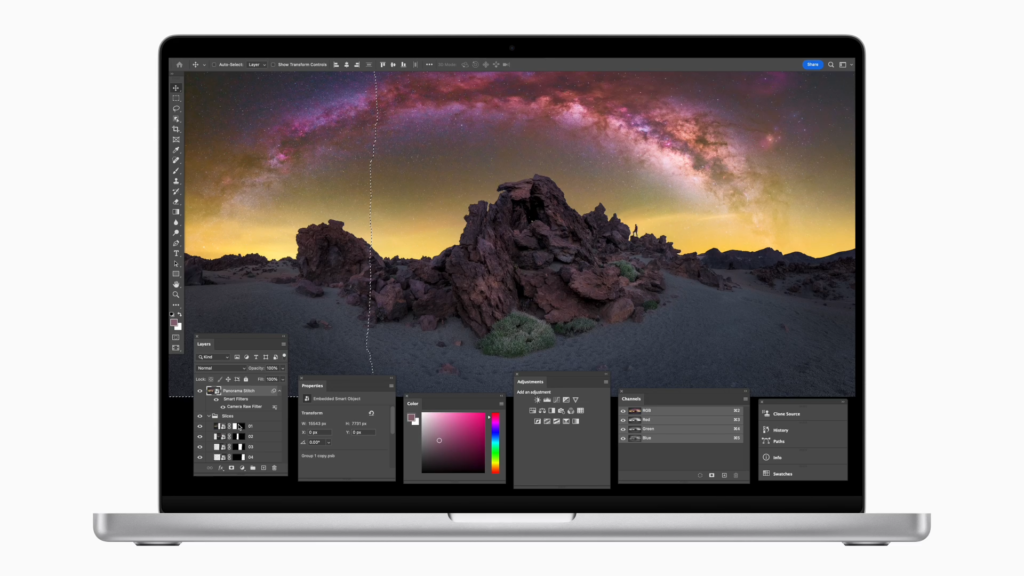RedMagic 10 Pro Series China Launch Date Confirmed, Key Features Revealed
Apple’s M3 Chips Family Unveiled – Scary Fast
Apple M3 Chips – In a rather unexpected move, Apple chose an unusual date for its announcement – a Halloween-themed keynote that sent chills down the spine of tech enthusiasts. What was on the agenda, you ask? Well, it was all about Apple’s Mac computing ecosystem and setting new benchmarks in performance.
Not too long ago, Apple bid farewell to Intel’s chips, making it clear that they were ready to march to the beat of their own chip-making drum. And now, in the ghostly ambiance of a Halloween presentation, Apple has unveiled not one, not two, but three new chips, the M3 family. These chips are poised to take the 14-inch MacBook Pro, 16-inch MacBook Pro, and the new 24-inch iMac line to greater heights.
Table of Contents
Meet the Apple M3 Chip Family
The M3 family, which consists of the M3, M3 Pro, and M3 Max, is armed with substantial enhancements in raw performance, graphics capabilities, and a particular focus on the MacBook series’ power efficiency, promising extended battery life. According to Apple, the new MacBook Pro 16 can now last a whopping 22 hours on a single charge, in specific usage scenarios.

M3: The Entry Spec
The M3 chip, as the entry-level option, boasts an 8-core CPU with 4 performance cores and 4 efficiency cores. Apple boldly claims that it’s up to 35% faster than the M1 and a remarkable 20% faster than last year’s M2. These improvements mark a significant leap from chips that were already setting performance benchmarks in comparison to Intel and AMD’s chips for Windows devices. The M3 also comes with a 10-core GPU featuring a new architecture.
Johny Srouji, Apple’s senior vice president of Hardware Technologies, exclaims, “With 3-nanometer technology, a next-generation GPU architecture, a higher-performance CPU, faster Neural Engine, and support for even more unified memory, M3, M3 Pro, and M3 Max are the most advanced chips ever built for a personal computer.”
Apple introduces dynamic caching, an industry first, allowing software to manage memory allocation for each app or game in real-time, significantly boosting performance. The new GPU offers Mesh shading and Ray Tracing, especially good news for graphics and gaming applications, as it promises more accurate shadows. Furthermore, the M3 family can be equipped with up to 24GB of memory, a notable first for Apple Silicon, bringing it on par with Nvidia and AMD’s dedicated GPUs. Game developers can now enhance detailing and shadow rendering using any of the M3 chips without the need for a dedicated GPU.
M3 Pro: A Step Up
The M3 Pro takes a step up, featuring a 12-core CPU, which is up to 20% faster than the M1 Pro. With 6 performance cores and 6 efficiency cores, alongside an 18-core GPU that encompasses all the M3’s features, this variant promises even more performance. Memory capacity gets a bump to 36GB.

M3 Max: The Pinnacle
At the pinnacle of the M3 family lies the M3 Max, sporting a 16-core CPU, with 12 performance cores and 4 efficiency cores. Apple claims that this behemoth offers overall performance up to 50% faster than the M2 Max and a staggering 80% faster than the M1 Max. It’s remarkable how far we’ve come in just a couple of years.

The M3 Max doesn’t disappoint in the graphics department either, as it flaunts a 40-core GPU, a memory capacity of up to 128GB, and a jaw-dropping 92 billion transistors. Apple proudly states that this will enable AI developers to work with even larger models with billions of parameters.
Keeping the Battery Alive
The remarkable thing about all these performance gains is that they don’t come at the cost of battery life. The efficiency cores on the M3 chips are up to 50% faster than those on the M1 and 30% faster than the M2, representing substantial generational improvements. Performance cores also see a boost of 30% compared to the M1 and 15% compared to the M2.
What About Gaming?
Now, let’s talk about gaming. All these hardware-driven improvements certainly provide game developers with some powerful tools for creating graphics-intensive masterpieces. But the big question remains: will enough developers be encouraged to accelerate the process of bringing games from other platforms, like Windows, to the Mac? This is the critical factor that will determine whether Macs can truly realize their potential as a gaming platform.

Nevertheless, with these powerful new M3 chips and the Game Porting Toolkit released over the summer, it seems like Mac gaming is slowly but surely moving in the right direction. Apple is clearly making strides to create a gaming ecosystem that can rival other platforms and open up new possibilities for developers and gamers alike.
In conclusion, Apple’s new M3 chips have set the bar high when it comes to performance and graphics capabilities. These chips, available in three variants, offer significant improvements over their predecessors and bring Apple closer to its goal of creating a gaming-friendly Mac ecosystem. The future looks promising for Mac users who are eager to explore the world of gaming and experience the power of these cutting-edge chips. With the M3 family, Apple has once again shown that it’s not just about following the trends; it’s about setting new ones. Happy gaming, Mac enthusiasts!
Share on :
Connect with us on:
Recent Upcomings
Latest electronics Deals








